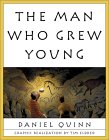

| The Man Who Grew Young. Written by Daniel Quinn. Illustrated by Tim Eldred. New York: Context Books, 2001. 98p. $19.95. ISBN 1-893956-17-2. |

|
GENRES: AUDIENCE: SYNOPSIS: Adam watches as people slowly dismantle American society, sucking smoke in via factories, removing scenes from photographs, trading computers for typewriters and paper, returning coal to the earth, taking down houses. His son is returned to his mother, and his marriage ends not long afterwards; Claire is introduced to him, and he never sees her again. Thus, he sets out on a search for his mother. In the American southwest, he moves in with Maria and her son Cecil, Native Americans who are confidently expecting America to be returned to them someday. Indeed, Maria is something of a seer, and she gives Adam a fossil fish that she claims came from his mother. As time rewinds, Adam discovers that he is Cecil's father; witnesses the end of the Atomic Age; accompanies the Europeans as they abandon America; and generally wanders into the simplifying future, the only person who recalls anything of the complicated past. In ancient Stonehenge, Adam meets several wizards and prophets, including Merlin, who knows a few things about the past, and Alta, who is taken from the water in a ritual that fetches a person from the river every year. Alta explains to her skeptical audience that time used to run in the opposite direction, and she tells Adam a story of a wandering young man; the story merges with Adam's life as he continues his wanderings through space and time. Ultimately Adam reaches the last town, where resides the last queen and her two sons. She invites Adam to becomes her husband, and he gratefully accepts. As he slowly dismantles the city, he tells the two boys stories of the past, and the queen tells him a creation (or, in this case, an un-creation) myth. Soon, however, he continues on his quest. At one point he is trapped in a glacier, but when he thaws after an indeterminate period, he meets a remnant of humanity, including the man who is destined to take the Lascaux cave paintings back into himself. At last Adam understands the black stain on his hand, and he figures out who his mother is. EVALUATION: One thing I really liked about the book was that when things "devolve," there is no sense of loss among people; rather, they are gaining in some way. For example, Maria returns a piece of turquoise to the earth, she is happy because she's giving the earth a treasure. And when an artist removes a picture from a cave wall, he's not emptying a cave but filling himself. "Paintings belong in people.... Every painting and every sculpture must absolutely end in the hand of some man or woman and be seen no more." I also like the use of myths and stories to illustrate key points. It would have been all too easy to provide the reader with dense lumps of philosophy, but Quinn keeps them clear, simple, and pointed, so that the book never drags. (BTW, I've classified the book as fantasy rather than science fiction or alternate history, which, strictly speaking it would normally be, because Quinn doesn't go into the "technical details" of backwards living--nothing about eating and excreting, for example [or would that be increating and barfing up?], or whether people wonder who created the coffins from which their loved ones emerge.) Because the purpose of the book is to get a point across, the characters aren't very vivid or three-dimensional. Adam is pleasant but bland, more of a passive observer than an active participant in the things that go on around him. The women who guide him tend to be preachy; they do a lot of the explaining in the book and are not meant to be realistic individuals. I like Eldred's art here a whole lot better than the pseudo-Japanese stuff he did for Project A-ko. It's simple but cinematic and vividly colored, and it complements the story nicely without either overpowering it or vanishing under the words. And some of the panels are very nice indeed, like the reverse nuclear explosion, or the ones with the sneaky reverse-creation touches (e.g., an In box is filled with typed sheets, while the Out box is filled with blank paper). I normally dislike philosophical stories, so it's a measure of The Man Who Grew Young's quality that I enjoyed it thoroughly and finished it with great admiration for Quinn's vision. Highly recommended for adult readers and collections, and for teens who have a taste for literary graphic novels or intelligent fantasy/SF. (Are there such animals? I surely hope so.) Though there's nothing objectionable in the book, kids would likely find it dull. This is another book you can trot out to disprove the claim that comics are solely a kids' medium, or that sequential art can't accommodate a deep story. |
Return to Rational Magic Home
